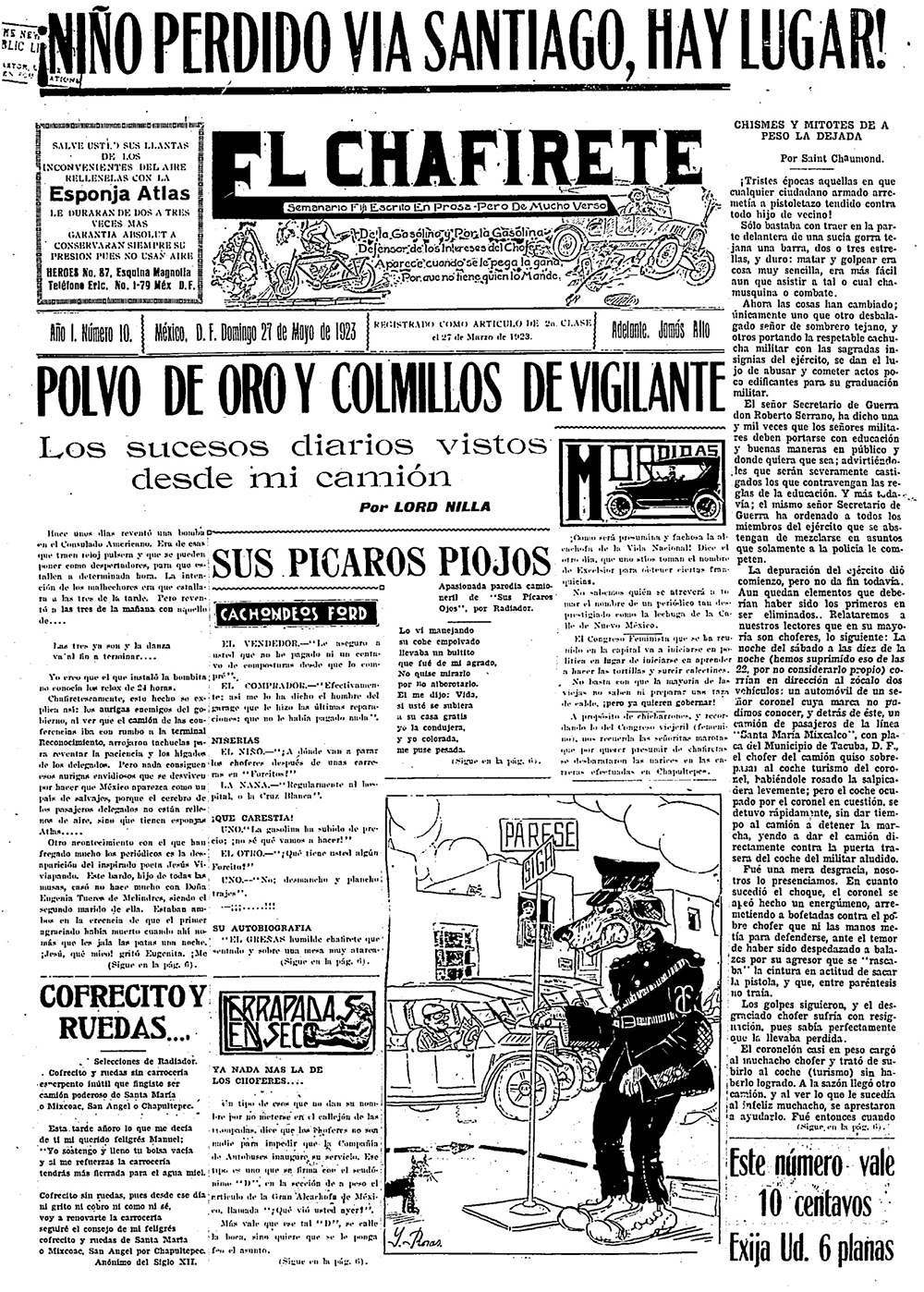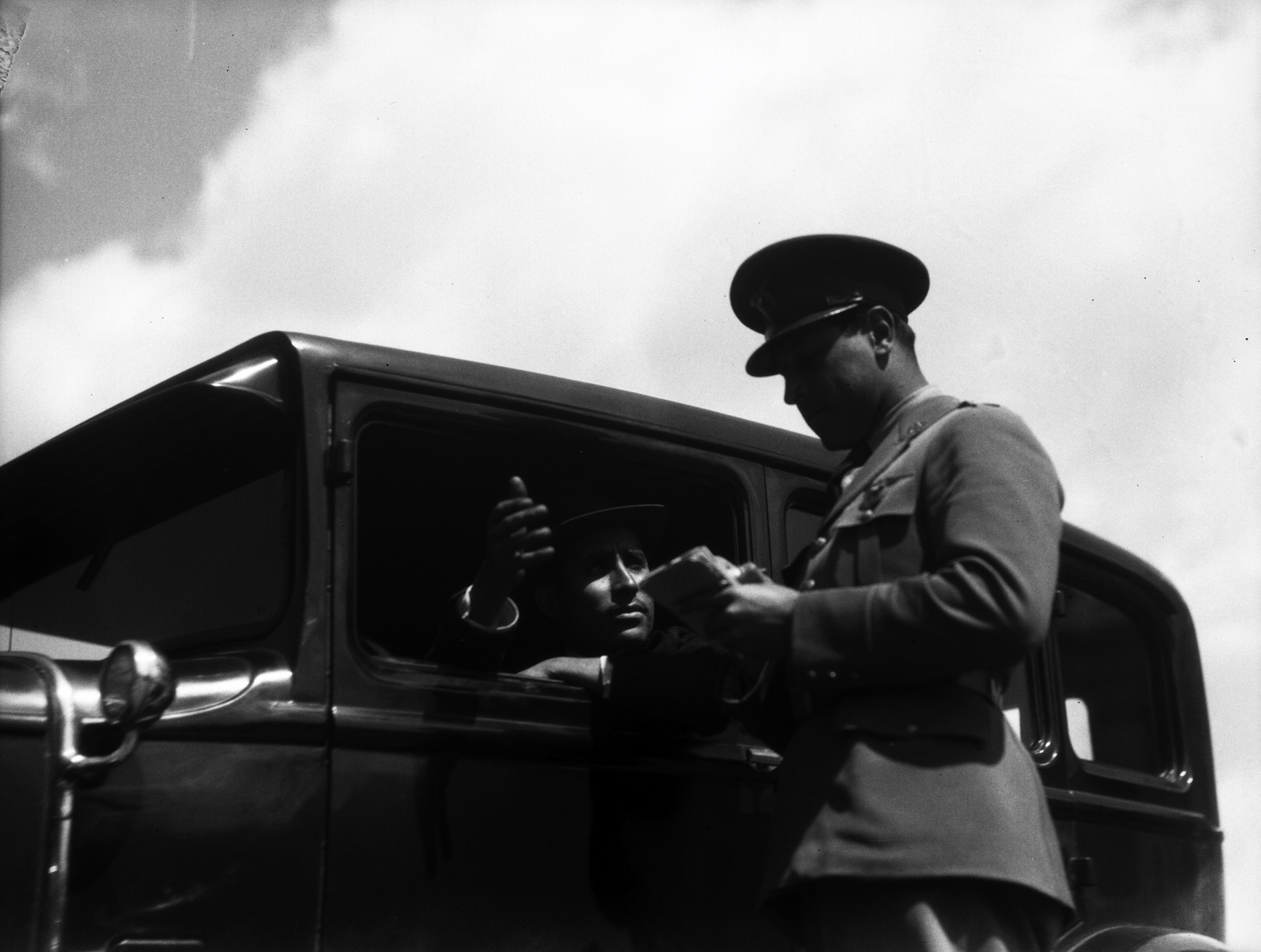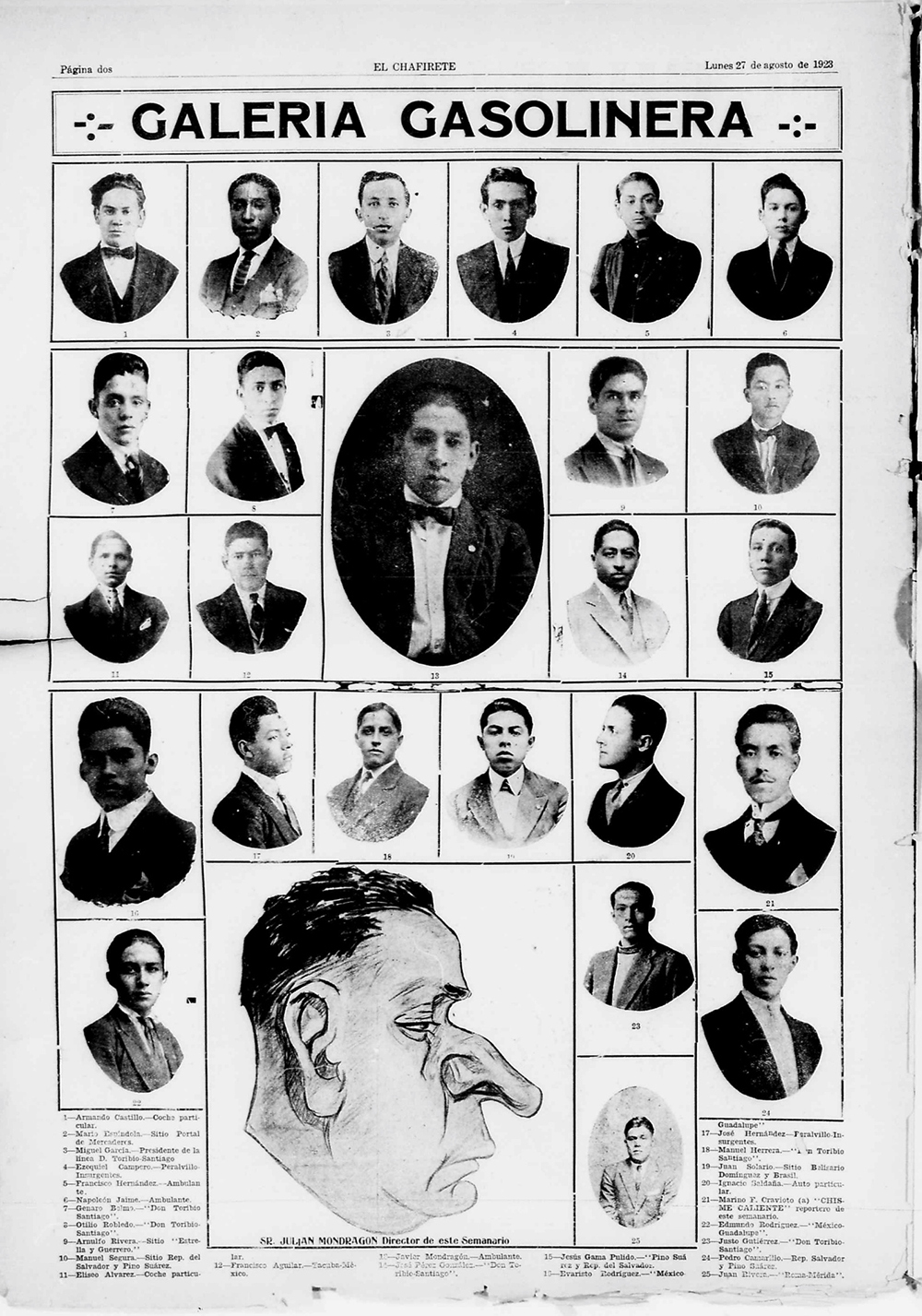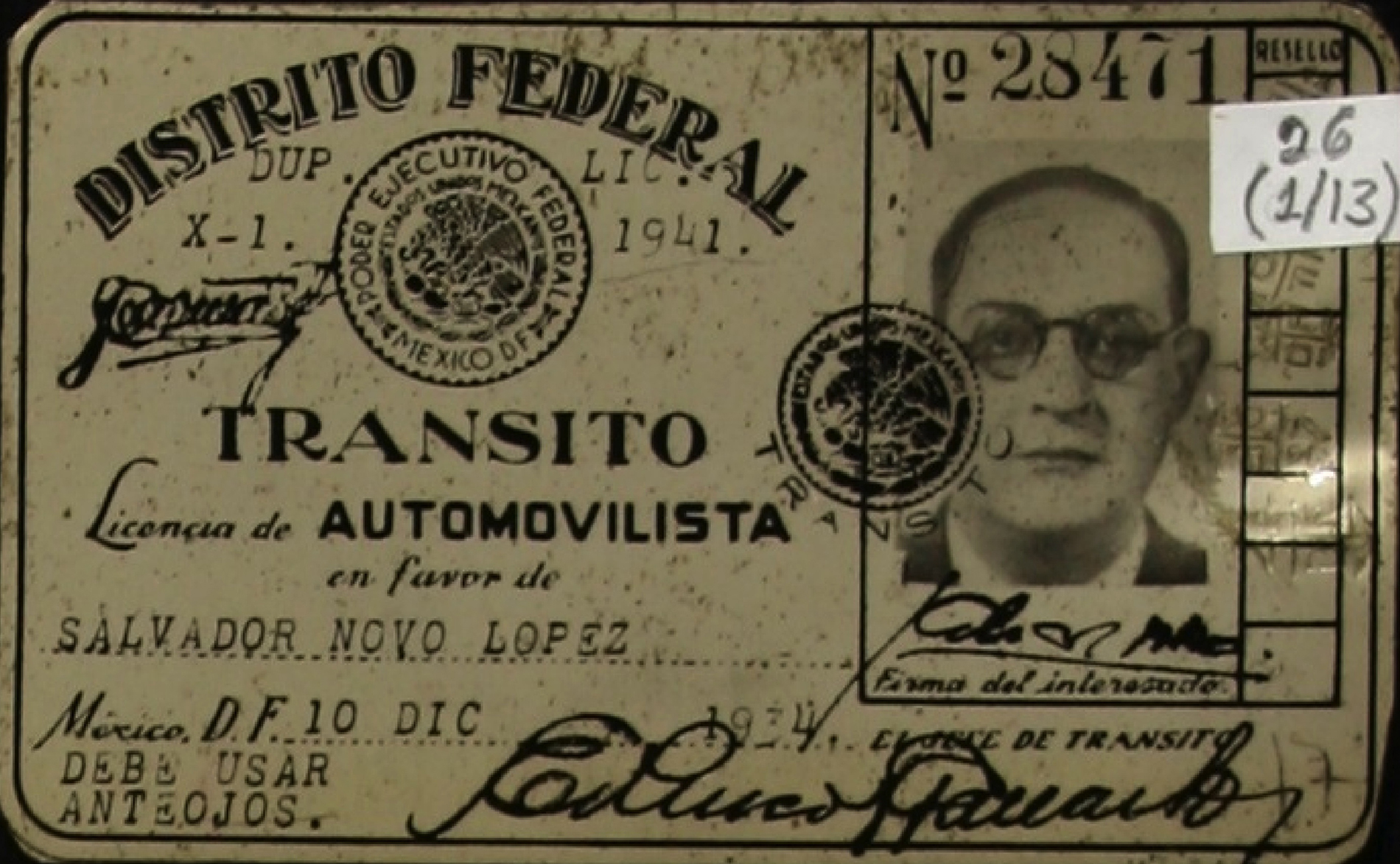“An insatiable thirst for meat and an audacity at the same time confident of my beauty and of my capacity to buy caresses sent me on a hunt for the genre of boys that electrified me to discover, tempt, squeeze: drivers, who in the small Mexico of that time were the young generation ushered in to operate the machines, to live swiftly.
El taxi (The Taxicab) by Manuel Rodríguez Lozano is a reflection on the connections between the life of writer Salvador Novo, his work, and transformations in urban life. Novo appeared in the foreground, sitting inside a car circulating through the central streets of Mexico City. He was wearing a robe. What was he wearing underneath? His lips looked tight, painted red. Eyebrows were well outlined. The street lamps lightened the iconic Main Post Office (Palacio Postal), at the intersection of the streets of Tacuba and San Juan de Letrán (currently known as Lázaro Cárdenas Axis Road). The clock was about to strike midnight, and Salvador Novo was moving through the district that welcomed dancing, drunkenness, and prostitution.
In this section, you will approach mobilities not as utilitarian activities —home-to-work commutes, for example— but as experiences that link the public space with intimacy, urban politics with popular culture, and urban transformations with art.
Novo’s gaze was fixed, but not on the spectator. Perhaps he was looking at the taxi driver, the absent protagonist of the portrait. As he wrote in his autobiography, Pillar of Salt:
Novo was also looking at the city in transition. His work recorded an everyday life woven together by trams —an icon of modernity just two decades earlier— and the influx of automobiles into the urban fabric. As a writer, Salvador Novo gazed at the city and at himself. For him, chafiretes (as car and bus drivers were known) synthesized a moral, aesthetic, and urban renovation. For us, both the writer and the chafiretes allow to gaze at mobilities as an all-encompassing experience.
Novo and the drivers crossed paths in the press. By 1923 (shortly before Rodríguez Lozano painted his portrait), the young writer was already the main editor of the weekly El Chafirete:
“A certain instinct had associated me with the founders of a weekly paper that provided with many easy contacts among its specialized readers: drivers and hawkers. Some of the best skins of the time came to me through El Chafirete. The editor-in-chief preferred paperboys who yelled the name of his newspaper; Don Derrapadas (who died shortly thereafter at Hospital de Jesús) preferred the young collectors; I preferred the more solid drivers.”
Novo, who signed under the nickname Radiator, and his colleagues Fray Fotingo (Brother Ford), Don Derrapadas (Mr. Skid), Abate Chorizo (Abbot Sausage), Doña Ford (Mrs. Ford), Volantero (Paperboy), covered news on lubricants and urban politics; accidents and the price of gasoline; the mechanics of Ford buses (known as Fotingos) and the Mexico Tramways Company; and the transit police whose proclivity to bribery gained them the nickname of mordelones (bitters).
“Semanario fifí escrito en prosa pero de mucho verso. De la gasolina y por la gasolina. Defensor de los intereses del chofer. Aparece cuando se le pega la gana. Porque no tiene quien lo mande.”
El Chafirete aimed to create an identity for the members of a trade that was both new and divided between taxi sites, bus routes, and private cars. According to El Chafirete, tax payments, license fees, and permits granted them rights and entitled them to “denounce all the arbitrariness and abuses [drivers] are subjected to by the police, the public, and the dictators of the traffic light.” However, unlike tramway workers from Section 1. Dependencies, El Chafirete called itself an enemy of “strike delusions” and “socially dissolving ideas.”
“What is a mordida [a bite]? The action of biting (with teeth, it goes without saying). A mordida can be when a dog sinks its teeth into your rear [arrejuntón de dientes]; it can be a hickey done with the lips, and it can be a rip-off [sablazo] by a chafirete to a bus or fotingo owner. There is another kind of mordida: those that transit policemen give to chafiretes when it comes to infractions.”
The signature irreverence of El Chafirete allowed for public explorations of homoeroticism. Novo played with the boundaries of drivers’ masculinity. El Chafirete depicted them as womanizers that ran away from marriage; their ideal was not beauty, but ugliness (the weekly had a contest for the ugliest driver in the city); their interests were urban politics and rave-ups. However, between euphemisms and explicit allusions, Novo created erotic dramas and comedies starring chafiretes, blurring the line between fiction and reality.
In August 1923, a “Gas Station Gallery” was published with 25 portraits of drivers, including their names and the routes they worked. El Chafirete did not explain the reasons behind publishing this photo series, but it probably was just another nod by Novo.
In his archive, Novo preserved similar portraits with affectionate dedications to Adelita /Adelito.
A love complaint appeared in El Chafirete under a similar pseudonym: “My lovely Samuel: Do you still work in Tacubaya-Mixcoac-San Ángel [a bus route]? Did you take me for a ride with that miserable woman you were going to marry? Aren’t you going to Torreón [Novo lived a few years in this city]? Did your surgery in the glans and butthole turn out okay? With adoration, ADELAIDA.”
Novo used the language of the automobile —sticks, lubricants, and drifts— for his literary games. Click to see his intervention in the poetry of Sor Juana Inés de la Cruz and Manuel Acuña in “Sonetos lubricantes de Sor Juana Inés del Cabuz” (“Lubricating Sonnets of Sor Juana Inés del Cabuz”) and “Nocturno a Rosaura por Manuel T. Acuña” (“Nocturne to Rosaura by Manuel T. Acuña”).
As Novo’s story shows, cars and buses were gradually incorporated into all areas of urban life from the first decades of the twentieth century. However, as you will see in section 3. Disputes, conflicts were part and parcel of the transition to an automobile city.








